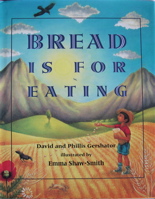|
|
|

|
BREAD
IS FOR EATING
co-author,
David
Gershator
illustrated by Emma
Shaw-Smith
Holt, 1995
|
*
Reading Rainbow Featured
Selection, PBS
*Trumpet
Book
Club
*Notable
Trade
Book, Field of Social
Studies
*Recommended
Literature, California Dept.
of Education, 2002
*Children's
Catalog, 2001
|
| From
the book jacket: |
Think
of the seed, asleep in the
ground.
Think
of the earth, a dark, cozy
bed.
All around
the world, people eat
bread--from tortillas and
baguettes to pitas, challah, and
sliced white. Here is a book for
very young children that
celebrates bread––and everyone
who works so hard to make
it––from seed to supermarket.
Readers will enjoy singing the
refrain and will learn Spanish
words, too!
The
rhythmic, bilingual text is
complemented by rich, vibrant
paintings, reminiscent of
Guatemalan folk art, that depict
a variety of peoples and breads.
|
| A
little about the book: |
Says Phillis--
I adore books about
"process." When I heard a Spanish
song about bread performed on TV
one night, I was inspired, and
with my husband David, a poet,
songwriter, and former Spanish
teacher, wrote a story about
bread, beginning with a grain of
wheat. David wrote a new song,
too, in English and Spanish, which
is included in the book and sung
on Reading Rainbow and our CD: This
is the Day!
Says David--
Anything that involves bread is
evocative. Bread resonates.
And this book is beautifully
illustrated––highly edible!
|
| From
the reviews: |
|
"Glowing with wheaten tones of
gold, the folk-art style
illustrations show the mother and
son in their cozy Latin American
farmhouse, as well as the cycle
that brings bread to tables all
over the world. Use as a
multicultural, musical lead-in to
Russell Hoban's Bread and Jam
for Frances, followed by Dr.
Seuss' Green Eggs and Ham,
for a story hour lineup guaranteed
to make mouths water and tummies
rumble." Booklist
Spanish and English are
blended seamlessly with the graceful
narrative. Shaw-Smith's heroic-style
pictures, filled with rich, glowing
reds and yellows, are crammed
with...details....Scenes are packed
in the way of gigantic Mexican
murals. Endpapers are a patchwork
quilt of tiny vignettes....These
images, vibrating with life and
color, are not to be missed." School
Library Journal |
|
|
|
|